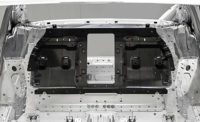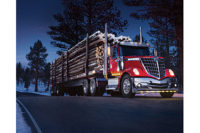Composites are becoming increasingly popular with body and trailer manufacturers. Most applications so far have focused on delivery trucks. For example, UPS has been experimenting with composites as a way to reduce the weight of each of its vehicles by 900 pounds, while improving fuel efficiency by 40 percent.
The company recently concluded a year-long pilot program to test the material’s durability, repair qualities and structural strength. Next, UPS will test composites in larger, heavier vehicles, such as tractor trailers, to see if the material is as well-suited there.
“The use of composites signals a strategic shift for UPS,” claims Dale Spencer, director of automotive engineering at the package delivery service. “In the past, [our delivery vehicles] were built like tanks, because they were kept in service for decades. Now, with different materials available, we are changing our mindset."
“Composites rival the fuel savings of alternative fuel vehicles, without the technology obsolescence threats, fueling infrastructure issues and production challenges that come along with natural gas, hybrids and electrics,” Spencer points out.
According to Spencer, UPS has purchased 150 composite-body vehicles from Utilimaster Corp. The trucks are expected to be received in the fourth quarter of 2012 and go into service on high-mileage routes, primarily in the Western region of the United States.
Spencer says UPS has experimented with some composites in previous vehicles, which used aluminum bodies. But, the new trucks extend the lightweight materials across the entire vehicle with the exception of the floor. “This area still requires metal structures to protect and support the weight of the shipments inside,” notes Spencer.
As a result, the new trucks feature aluminum floors. But, many different types of plastics are used throughout the vehicle. For example, the truck’s hood and roof are made from a single molded piece of fiberglass-reinforced plastic. Front fenders and lower body panels are made from injection-molded polyurethane, while structural components are made from polyethylene.
“A year’s worth of testing five package cars in high-mileage settings showed that composites are durable, work well in all kinds of climates (especially where corrosion from road salt is an issue) and are easily repaired since they are modular,” claims Spencer. The high-profile application is expected to jump-start demand for composites in the trucking industry.
Composites ‘Deliver’ Light Weight in Trucks







